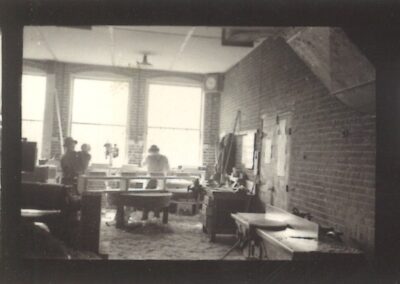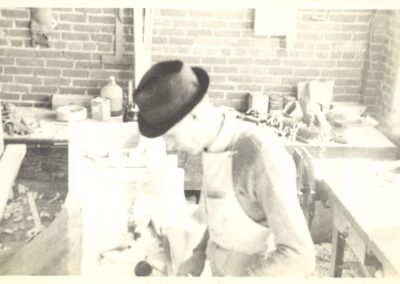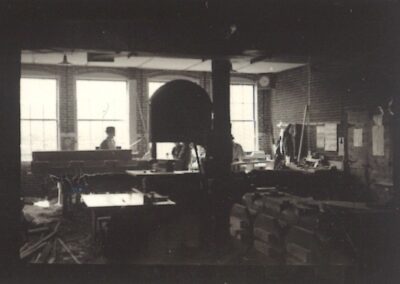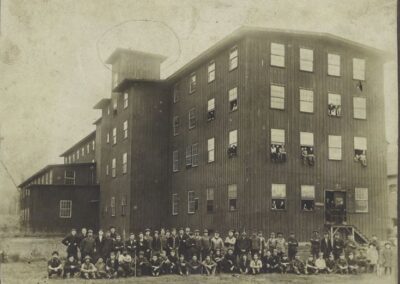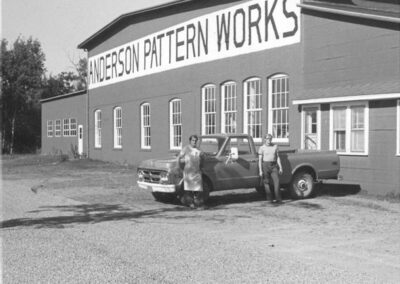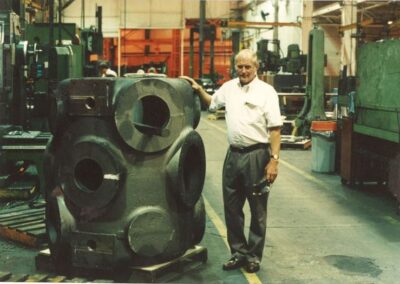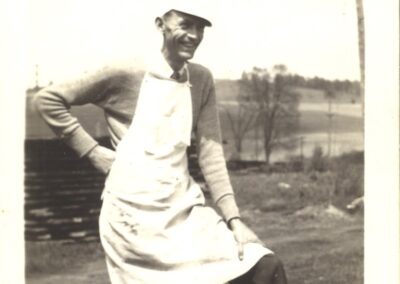History


In 2016 Bill and Kay Anderson took us on a little excursion to visit the Anderson Pattern Works building which had been closed since Bill’s retirement in 2004. When we entered the building we could immediately see past the dirt and dust that built up in 12 years of nonuse. The time clock in the hallway so clearly marked the days of the past to us as we walked past. Light filtered through windows punished by dusty winds and passing trains. Sawdust was in the air and underfoot. We wandered from one room to the next past large pieces of equipment, all kinds of saws, drill presses, work benches and wonderful old tools. There is something here, an energy that is difficult to describe and yet it is palpable. Since then friends, family and customers have enjoyed the energy and charm of these old brick walls. Perhaps it is all the history in this building, perhaps echoes of the joy or satisfaction taken in doing quality work or gratitude for a job and the ability to support one‘s family. Since that day and our subsequent purchase of the property and its contents we have worked hard to build the retail space and woodshop you see here today – we have thoroughly enjoyed uncovering the history and learning the buildings’ secrets.
What of the history of the building? It was initially built as a machine shop, boiler and compressor house for The Roulette Leather Tannery. In short it was the heartbeat of the facility. There remain today visible scars where compressor belts occasionally broke and hit the walls, brick floors now covered in concrete and stains of coal and machinery use. We think of them as character marks, the pieces of our past we want to preserve and build on for the future.
The Roulette Leather Company began in 1866 by Darius Wheeler and Henry Dusenbury, during the company’s growth they built a four story tannery on this property. In 1905 a devastating tornado tore through the east end of Portville tearing the roof and top story off the main tannery building and inflicting serious damage on most of the other buildings. The Compressor plant/ machine shop and the small lab building behind it, however, remained largely intact. It The building was rebuilt and In 1911 the tannery was sold to the Northwest Leather Company of Michigan when again disaster by way of fire destroyed the tannery portion of the grounds. Opting not to rebuild in 1929 the company moved equipment and operations to its Michigan plant. In 1930 Frank Lunn and Earl Dickinson purchased the portion of the property on which the compressor plant and lab buildings stood and opened the Portville Lumber Company which operated from this facility for 6 years.
In 1936 John R. Anderson purchased the property with two buildings and opened the Anderson Pattern Works. He operated this business for the next 40 years and among his long-time employees and protégés were his two nephews Bill and Dave Anderson. In 1976, following John’s death, Bill and Dave purchased their uncle’s company and continued the family business and tradition for another 28 years until health issues forced their retirement in 2004.
Pattern making is both an art and a science requiring knowledge, skill and precision. Looking at these complex patterns one can easily understand the satisfaction in the work. We feel this same pride in the work we at Rusty Rooster are doing as providing unique pieces to our customers. After we purchased the Anderson Pattern Works and the building’s contents, we were privileged to work with Bill Anderson until his passing in 2018. He spent hours talking to us about the building and working with us as we familiarized ourselves with various pieces of equipment. We will be forever grateful. Renovation and restoration of the Anderson pattern Work buildings has been a labor of love and a family affair. We have enlisted, and sometimes drafted our children, family and friends to help.
Uncovering the past has been an adventure. We have made a conscious decision to retain some of the indications of the people who came before us. We will not paint over the notations written on the wall nor fill-in the various carvings in the brick. These marks are evidence of the people who were here before us and we will honor their presence. As you browse our showroom and tour our facility your will see photos of Bill and his employees and the patterns they built. Bill’s work bench and tools are preserved as a testament to his work and many other pieces are used as beautiful displays. While our products and services are very different from theirs, we use many of the same woodworking tools and equipment and strive to create the quality in our pieces that Bill, Dave and their employees achieved.

